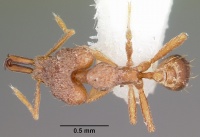Strumigenys amnesia
| Strumigenys amnesia | |
|---|---|

| |
| Scientific classification | |
| Kingdom: | Animalia |
| Phylum: | Arthropoda |
| Class: | Insecta |
| Order: | Hymenoptera |
| Family: | Formicidae |
| Subfamily: | Myrmicinae |
| Tribe: | Attini |
| Genus: | Strumigenys |
| Species: | S. amnesia |
| Binomial name | |
| Strumigenys amnesia Bolton, 2000 | |
Strumigenys amnesia has been collected in primary and old secondary forests (Tang & Guenard, 2023).
Identification
Bolton (2000) – A member of the koningsbergeri complex in the Strumigenys koningsbergeri-group. See Strumigenys chorosa.
Tang & Guenard (2023) - Bolton (2000) noted that workers from Thailand and Sumatra (HL 0.64–0.69, MandL 0.28–0.33, SL 0.35–0.39) were slightly smaller than the type specimens from Malaysia (HL 0.72–0.76, MandL 0.34–0.36, SL 0.42–0.44). The workers from Thailand we measured (HL 0.63–0.66, MandL 0.29–0.30, SL 0.34–0.37) also had morphological measurements that fell within the typical range reported by Bolton.
Keys including this Species
Distribution
Latitudinal Distribution Pattern
Latitudinal Range: 7.35° to 7.35°.
| North Temperate |
North Subtropical |
Tropical | South Subtropical |
South Temperate |
- Source: AntMaps
Distribution based on Regional Taxon Lists
Indo-Australian Region: Malaysia (type locality).
Oriental Region: Thailand.
Distribution based on AntMaps
Distribution based on AntWeb specimens
Check data from AntWeb
Countries Occupied
| Number of countries occupied by this species based on AntWiki Regional Taxon Lists. In general, fewer countries occupied indicates a narrower range, while more countries indicates a more widespread species. |

|
Estimated Abundance
| Relative abundance based on number of AntMaps records per species (this species within the purple bar). Fewer records (to the left) indicates a less abundant/encountered species while more records (to the right) indicates more abundant/encountered species. |

|
Biology
|
Castes
Nomenclature
The following information is derived from Barry Bolton's Online Catalogue of the Ants of the World.
- amnesia. Strumigenys amnesia Bolton, 2000: 838 (w.) WEST MALAYSIA.
Unless otherwise noted the text for the remainder of this section is reported from the publication that includes the original description.
Description
Worker
Holotype. TL 2.6, HL 0.74, HW 0.62, CI 84, ML 0.34, MI 46, SL 0.43, SI 69, PW 0.32, AL 0.68. With characters of koningsbergeri-complex. Preocular concavity forms a broad depression on ventral surface of head. Upper scrobe margins constricted and concave above eye, entire eye visible in full-face view but its inner margin only just clear of the line of the scrobe margin. Edge of upper scrobe margin with a few minute tubercles but without a row of triangular teeth and lacking a decidedly jagged appearance. Depression across posterior vertex of head broad and shallow but distinct. Pronotum with a pair of short standing hairs close to anterodorsal margin. Pronotal humeral hair stiff, straight and simple. A single erect pair of hairs on mesonotum. Katepistemum and at least upper half of metapleuron smooth. Bullae of femoral glands absent on middle and hind legs. Lamella on propodeum narrow, its posterior (free) margin usually concave for most of its length but more or less straight in some. Standing hairs on first gastral tergite simple and cylindrical, pointed apically.
Paratypes. TL 2.6-2.7, HL 0.72-0.76, HW 0.63-0.65, CI 85-88, ML 0.34-0.36, MI 47-48, SL 0.42-0.44, SI 66-70, PW 0.32-0.33, AL 0.68-0.72 (3 measured).
Non-paratypic workers from Thailand and Sumatra are slightly smaller. HL 0.64-0.69, HW 0.56-0.61, CI 86-88, ML 0.28-0.33, MI 44-49, SL 0.35-0.39, SI 63-66 (4 measured).
Type Material
Holotype worker (upper of two workers on pin), Malaysia: Pahang, Cameron Highlands, Gunung Jasar, 1720 m., 25.iii.1993, #19b (Lobl & Calame) (Musee d'Histoire Naturelle Genève). Paratypes. 3 workers with same data as holotype (MHNG, The Natural History Museum).
References
- Bolton, B. 2000. The ant tribe Dacetini. Memoirs of the American Entomological Institute. 65:1-1028. (page 838, worker described)
- Khachonpisitsak, S., Yamane, S., Sriwichai, P., Jaitrong, W. 2020. An updated checklist of the ants of Thailand (Hymenoptera, Formicidae). ZooKeys 998, 1–182 (doi:10.3897/zookeys.998.54902).
- Tang, K. L., Guénard, B. 2023. Further additions to the knowledge of Strumigenys (Formicidae: Myrmicinae) within South East Asia, with the descriptions of 20 new species. European Journal of Taxonomy 907, 1–144 (doi:10.5852/ejt.2023.907.2327).
References based on Global Ant Biodiversity Informatics
- Bolton, B. 2000. The Ant Tribe Dacetini. Memoirs of the American Entomological Institute 65

